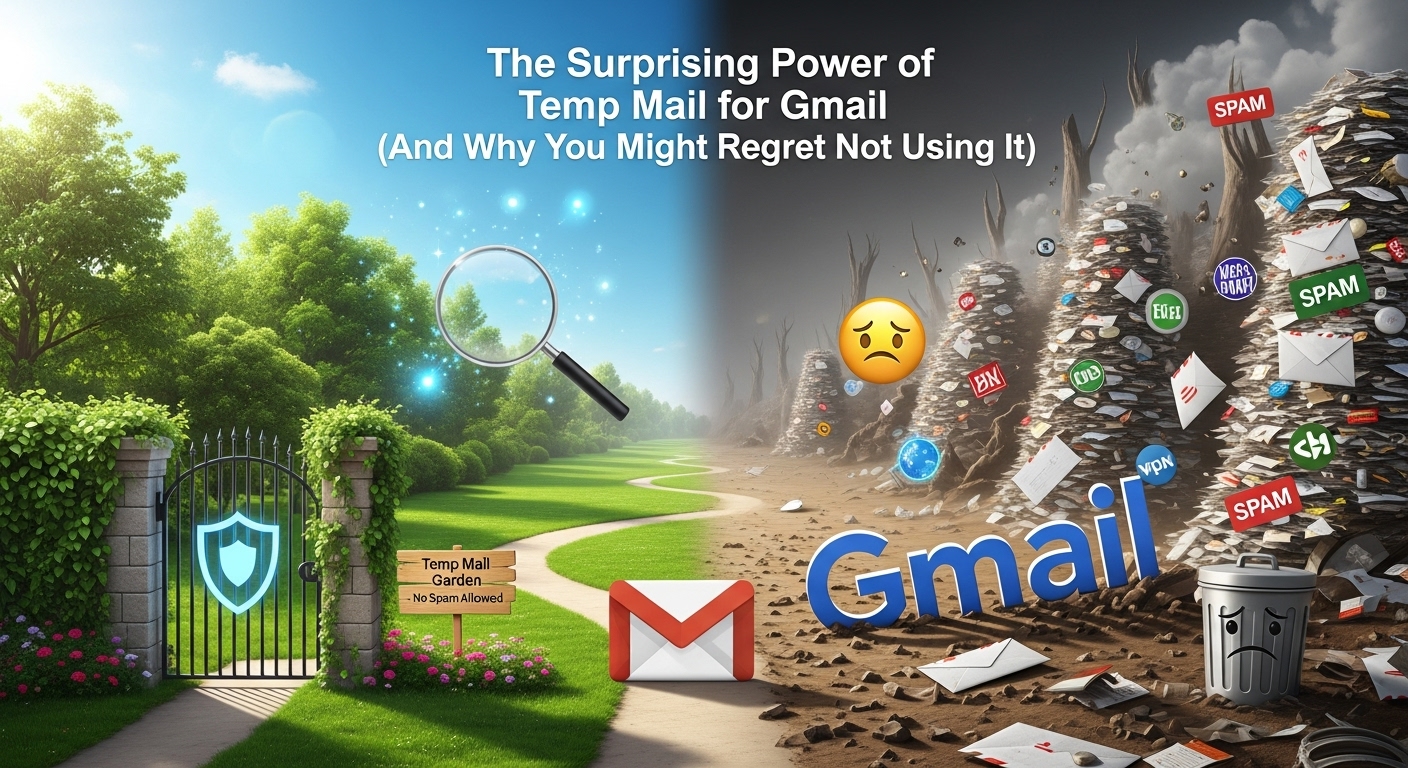The Surprising Power of Temp Mail for Gmail (And Why You Might Regret Not Using It)

Looking for a safe and private way to use temp mail for Gmail? This detailed guide dives into how disposable email services work, when to use them, when they backfire, and how to integrate them smartly with your Gmail accounts. We also explore pros, cons, real-life use cases, tips, and FAQ. Related long-tail keywords: “temporary gmail address tool,” “disposable email and Gmail integration,” “use temp mail services with Gmail safely,” “temp mail for Gmail privacy hack”, and “Gmail alias vs temp mail services.”
1. Why Use a Temp Mail for Gmail?
When signing up on the web, many sites demand your email. But handing over your real Gmail address often invites spam, trackers, or phishing. That’s where temp mail for Gmail comes in.
- Protect your main inbox: You can use a temporary address instead of your regular Gmail for risky registrations or one-time deals.
- Avoid spam overload: Once you’re done, you just drop the temp address – no more newsletters or unwanted promos.
- Maintain anonymity: Your real identity stays hidden, and your Gmail remains shielded.
- Test services easily: If you manage apps or websites, temp mails help you spin up test accounts without cluttering your inbox.
This method gives you a protective buffer between you and random/untrusted websites.
2. How Disposable Email Services Work — The Basics
A disposable email service gives you an email address you can use temporarily. Some defining traits:
| Feature | Description |
| Receive-only | You usually can receive emails but not send from that address |
| Short lifespan | Emails and the address expire after minutes or hours |
| No registration | You often don’t have to sign up or provide identity |
| Anonymous | It doesn’t tie to your real identity or main email |
These services pool domains, rotate addresses, and auto-delete mailboxes to avoid spam and blocklisting.
For example, Temp-Mail.org offers temporary email addresses that self-destruct after some time. (Temp Mail) The idea is simple: use the address, get confirmation or an OTP, then discard it.
3. Gmail + Temp Mail: Two Popular Integration Methods
You might ask: how do you pair temp mail for Gmail in practice? Two routes stand out:
A. Gmail Aliases (Plus Addressing)
Gmail supports “plus addressing”: you can add +something to your username and still receive mail in your main inbox.
E.g. yourname+promo@gmail.com.
This isn’t truly “temp mail,” but works well for many signup needs.
Pros:
- No external service
- You don’t lose access
Cons:
- It’s visible you use Gmail
- Some sites reject + addresses
B. True Temp Mail Forwarded to Gmail
Use a disposable email provider to generate a temporary address, then forward received messages to your Gmail.
This lets you enjoy full privacy but still view messages in Gmail.
This second approach is what people often mean by temp mail for Gmail.
4. Use Cases: When Temp Mail for Gmail Saves the Day
Here are real situations when I’ve leaned on temp mail + Gmail:
- Signing up for free trials or webinars — Many sites push marketing emails later.
- Testing new apps or UIs — I create dummy accounts without polluting my real Gmail.
- Accessing gated content — Sometimes sites lock content behind email forms.
- Avoiding reuse of your real email — On forums, giveaway sites, or sites you don’t trust.
- Temporary projects or collaborations — Use a temp address for a short campaign or event.
These help you keep your main Gmail clean, private, and spam-free.
5. Risks & Downsides of Using Temporary Emails with Gmail
Nothing is perfect. Using temp mail with Gmail has drawbacks:
- Blocked by sites: Some platforms detect disposable-email domains and reject them.
- No long-term access: Once the temp address expires, you lose all access to those emails.
- Security risk: If provider is compromised, your temp emails may leak.
- Missing critical mails: You might miss password resets or receipts if tied to temp addresses.
- No sending: Most temp emails are receive-only, so outbound messages aren’t possible.
Because of these, temp mail for Gmail is best for one-off or low-risk tasks, not essential services (banking, recovery emails, etc.).
6. Choosing a Reliable Temp Mail Service
To use temp mail for Gmail safely, pick a good provider. Here’s what to look for:
- Domain reputation & rotation: Good services rotate domains to avoid blocks.
- Inbox capacity & lifespan: Some allow a few hours, others days.
- Forwarding support: Ability to forward to Gmail is key.
- No logging / privacy policy: The provider shouldn’t store your data permanently.
- Attachment support & read access: If you expect attachments in the mail you receive.
- Uptime & reliability: You don’t want your temp email to fail when verifying an account.
Examples include Temp-Mail.org (a popular throwaway email provider) (Temp Mail) or TMailor.com (which supports auto-delete and multiple domains) (TMailor.com).
Also, internal links can help users trust: as you read here, I mention [https://temptomail.org] for a temp mail reference.
7. Step-by-Step: Using Temp Mail with Gmail
Let me walk you through using temp mail for Gmail safely:
- Pick a trusted temp mail service (like Temp-Mail.org or TMailor).
- Generate a new temporary address from their site.
- Set up forwarding to your Gmail (if service allows).
- Use the temp address when registering or verifying on websites.
- Check the temp inbox for confirmation / OTP.
- Once done, delete or expire the temp email.
- Optionally blacklist future mails from that domain in Gmail.
By the end, your Gmail is free from clutter, but you still got your needed confirmation or content.
8. Tips for Maximizing Privacy & Avoiding Blocks
Here are some extra tips to make temp mail for Gmail more robust:
- Use multiple temp addresses for different categories (e.g. “one-time deals,” “testing,” “forums”).
- Don’t reuse same domain everywhere — websites may flag it.
- Rotate providers if one domain gets blacklisted.
- Immediately discard unused addresses — reduces exposure.
- Whitelist only the confirmations you want in Gmail.
- Use browser incognito when generating to avoid leaks in cookies.
- Avoid using for sensitive accounts (banking, important accounts).
- Record which sites you used each temp address for, so you don’t lose track.
These small habits help you enjoy temp mail for Gmail without major headaches.
9. How I Used Temp Mail for Gmail to Test SaaS Tools
When I onboarded to 10 new SaaS tools recently, I didn’t want each one spamming my main Gmail. I:
- Created 10 temp addresses using a service.
- Forwarded them to a subfolder in Gmail.
- Signed up, used the service for trial, then let the temp expire.
- Gmail stayed clean, and nothing essential went to the trash.
In one case, the SaaS support reached out post-trial — luckily I forwarded that message in time. But otherwise, the experiment was seamless.
You can adopt this same system when testing, comparing tools, or exploring offers without risking your email.
10. Pros and Cons at a Glance
| Pros | Cons |
| Keeps Gmail clean & spam-free | Some sites reject disposable domains |
| Enhances anonymity | Risk of losing access to emails |
| Easy to spin up for testing | Not suited for long-term or important accounts |
| Helps avoid promotional clutter | Limited or no sending capabilities |
Use temp mail for Gmail only when benefits outweigh the risks.
11. FAQ – 10 Common Questions Answered
Q1: Is it legal to use temp mail with Gmail?
Yes — using disposable emails is not illegal. Just don’t use it for fraudulent or illegal purposes.
Q2: Will Gmail block forwarded mails from a temp service?
Gmail sometimes flags them as spam. Use filters and whitelist to ensure delivery.
Q3: Can I send emails from a temp email?
Most services only allow receive access — sending is usually disabled to prevent abuse.
Q4: What lifespan do temp mail addresses have?
Between minutes to hours, sometimes days, depending on the provider.
Q5: Will important emails (like password recovery) be lost?
Yes. That’s why you should never use temp addresses for critical services.
Q6: Can websites detect disposable email domains?
Many do. Some maintain blacklists of common temp domains.
Q7: Can I reply to a forwarded temp email from Gmail?
Usually no — replies go through your main Gmail. You lose anonymity if you reply.
Q8: Should I use alias “+addressing” versus temp mail?
Aliases are safer for continuity but less private. Use both depending on need.
Q9: Can I reuse a temp address?
Some services allow reuse or token-based recovery. Others permanently expire. Check provider features.
Q10: How do I avoid Gmail marking temp emails as spam?
Set up a filter: “Never send to spam” for sender address or domain. Also, add to contacts.
12. Conclusion & Final Thoughts
Using temp mail for Gmail is a clever, powerful hack when you want privacy, cleaner inboxes, and safer signups. But it’s not a silver bullet. Choose when it fits — for one-time tasks, testing, or low-risk accounts — and avoid it where long-term access or security matters.
By combining best practices (rotating providers, immediate discard, forwarding filters), you can get the benefits with minimal downside.
If you'd like a walkthrough of setting this up with a specific temp mail provider, or a comparison of top services, I’m happy to help.
Please don’t forget to leave a review of my article
Links
- For an in-depth disposable email generator: Temp-Mail.org
- On privacy and temp mail — Reddit discussion about best services (Reddit)
- Gmail alias & disposable email creation guide (GeeksforGeeks)
- TMailor temp email generator details (TMailor.com)
If you like, I can generate a snappy meta description, social media posts, or image suggestions for this article.
You Might Also Like
Is Your Inbox Spying on You? Here’s How AdGuard Tempmail Fights Back
Have you ever paused before entering your email address into a new website, feeling a slight hesitation? That feeling is...

The Shocking Truth About Edu Tempmail: Your Ultimate Guide to Discounts and Dangers
Imagine getting over 60% off Adobe Creative Cloud and half-price Amazon Prime. What if you could get those deals without...

Why Your Hotmail Is a Privacy Nightmare (And How Temp Mail Can Save You)
Did you know that nearly half of all emails sent worldwide are spam? In 2024, spam accounted for a staggering 47.27% of ...

The Ultimate Deception: Is Tempmail Safe, or a Ticking Time Bomb?
Your email inbox is more than just a place for messages. It's the digital key to your entire online life. Every password...

The Ultimate Betrayal: How Your Inbox Is Selling You Out (And How to Use Tempmail to Stop It)
Your inbox is a battlefield. Every single day, a war is waged for your attention, your data, and your money. Don't belie...

Your Digital Shield: The Astonishing Truth About How Temp Mail Works
Opening your email inbox can feel like walking into a battlefield. You’re constantly dodging a barrage of promotional ju...

